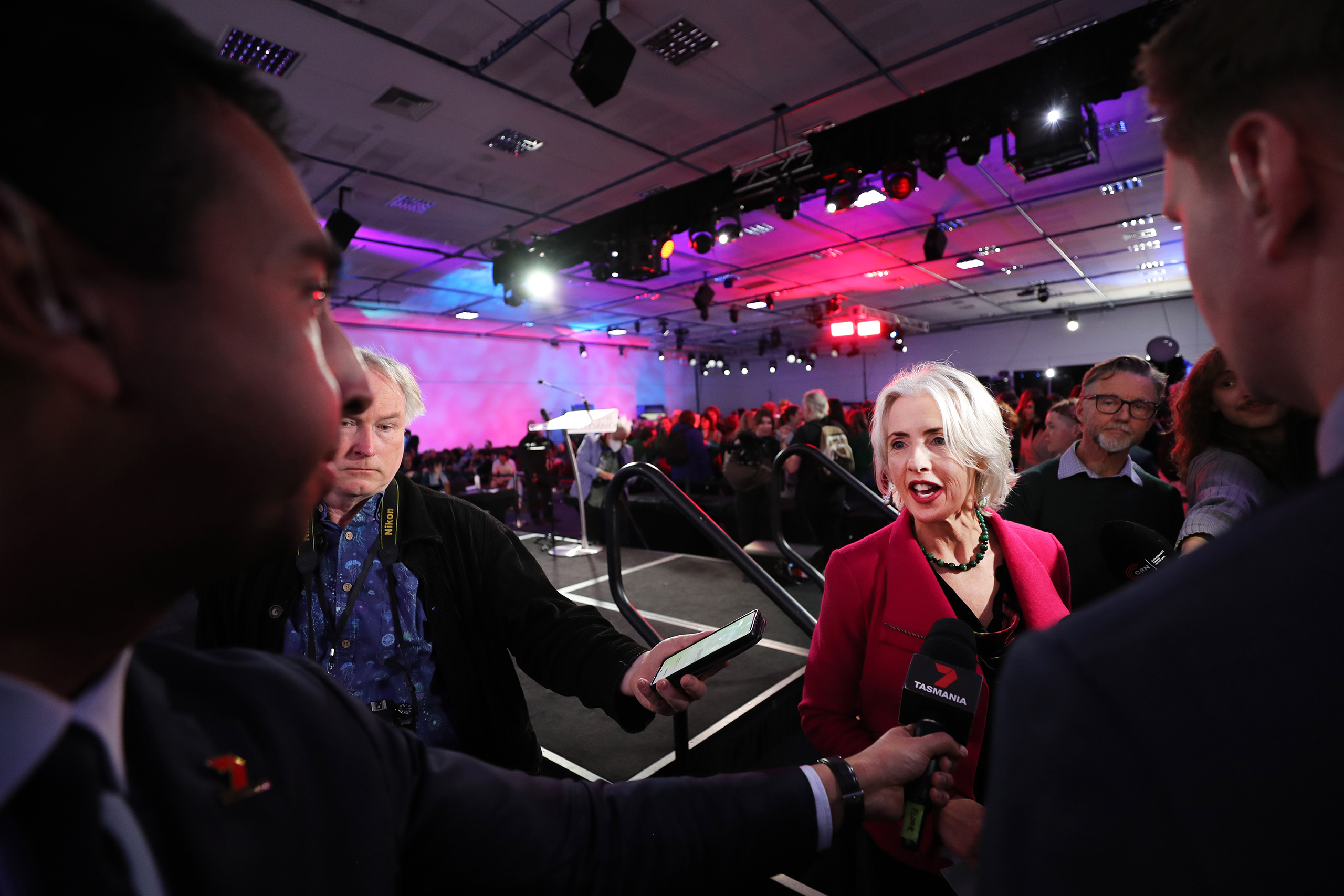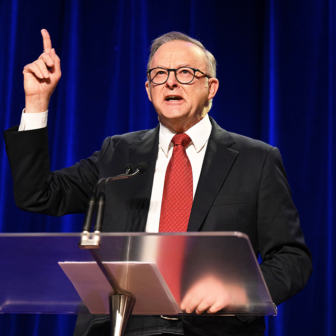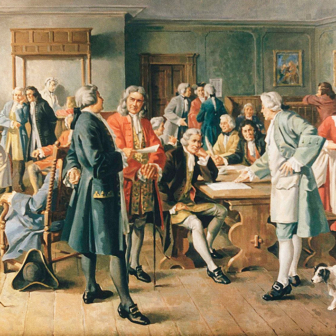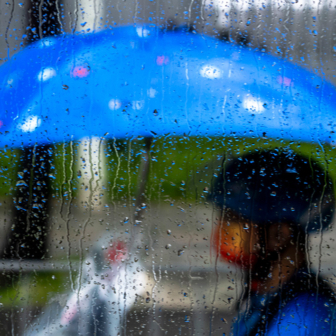Tasmania presents something of a political conundrum. Back in May 2023 its Liberal government fell into minority after the defection of two members, John Tucker and Lara Alexander. Premier Jeremy Rockliff was unable to strike a working relationship with the newly independent pair, or to retain their confidence as crossbenchers, partly because they opposed the AFL’s planned 23,000-seat stadium adjacent to Hobart’s historic waterfront precinct.
The premier called an early election for March 2024 won only fourteen seats in a House of Assembly that had expanded from twenty-five to thirty-five. Labor won ten, the Greens five, the Jacqui Lambie Network three and left-leaning independents three. To hang on as head of a minority government, Rockcliff struck confidence-and-supply agreements with the Lambie Network members and two of the independents.
Tasmanians were back at the polling booths a fortnight ago after Labor moved a successful motion of no confidence in the premier. Again, Jeremy Rockliff had been unable to keep the crossbench onside, but rather than resign he took Tasmanians back to the polls. Throughout the campaign, his policy demeanour remained “my way or the highway” as he pushed along the Liberal Party’s 2030 Strong Plan.
Post-election, the makeup of parliament has changed remarkably little. Neither major party has a majority, but the Liberals have slightly more support than before and Labor slightly less. The Greens and the independents are back, but not the Jacqui Lambie Network members, and the counting continues for the remaining few seats. The premier has begun talking to the crossbench but has telegraphed that he wants to get on with the job of implementing his party’s plan. And Labor will attempt to form government if he can’t.
The problem is clear. The major parties don’t share the concerns the leftist Greens and independents will bring to minority-government negotiations and to parliament. They are not minor concerns: they are why the crossbenchers are in politics. Invariably they touch on Tasmania’s environment, government transparency and accountability, the need for powerful political backers to be kept at arm’s length, and the integrity and intrinsic value of public spaces.
Tasmania’s conundrum resonates around the country. It raises the key question: is it possible to govern when the major parties no longer attract majority support?
Across Australia, twenty-five state- and territory-level minority governments have held power since 1989. Given that more than two-thirds of them ran full term, minority government can be made to work. And it’s important to remember that Labor was widely expected to be returned in minority at the May federal election. Even though the government won by a landslide, independents and minor parties surpassed the Coalition vote and were within a whisker of Labor’s share of first preferences.
Although a two-party-dominant system took hold federally a decade or so after federation, the picture was different in the states. Between 1910 and 1977 state governments spent around a third of the time in minority — except in Queensland, which experienced no minority governments. In South Australia and Western Australia, about 20 per cent of government years were spent in minority; in Victoria the figure was more than 50 per cent, and in Tasmania it was even higher.
Political scientist Jeremy Moon draws on these cases to define several types of minority government. Under ersatz majoritarianism the crossbench is compliant with the minority government. In an ersatz coalition the minority government largely accommodates the interests of the crossbench. Under ad hoc minoritarianism the crossbench unsystematically challenges the minority government. And minoritarianism prevails when crossbenchers, for example left-leaning independents and Greens, systematically pursue change.
These categories only matter because of the dramatic nationwide fall in major-party support. Federally, for instance, the combined Coalition–Labor vote fell from 91.8 per cent in 1987 to 66.4 per cent in 2025. During this period Labor prime minister Julia Gillard struck deals with the crossbench to support her minority government for the full 2010–13 term. Later, following the loss of three Coalition MPs, prime minister Scott Morrison’s government fell into minority, surviving as an ersatz majoritarian government until the 2019 election.
Analysing the twenty-five power-sharing governments at the state and territory level since 1989, the Australia Institute finds that they vary markedly, take time to negotiate, and typically result in the crossbench pursuing resources, reforms and occasionally ministries. They are usually based on formal agreements, involve the crossbench sponsoring legislation, and run full term. Such governments may follow elections, or form after a government loses its majority. Just as we see in Europe, it may not be the party with the highest vote that is able to form government.
In Tasmania, an ersatz Labor–Green coalition existed in 2010–14, but the Greens certainly didn’t have all their interests accommodated. The last two Liberal minority governments have been subject to substantive ad hoc minoritarian challenges, which were resented by the government and used as justification for early elections. Tasmania’s more recent parliaments, though, have very clearly been minoritarian rather than majoritarian.
Now, the Tasmanian Liberals are pursuing ersatz majoritarianism — in other words, behaving as if they are still in majority government — but the crossbench is in no way compliant.
Independents and defectors to the crossbench have always existed in Tasmania, and even the domineering Labor premiers Albert Ogilvie, Robert Cosgrove and Eric Reece relied on them at times to form minority governments. The rise of the Greens, however, was a major disruption to Tasmania’s conservative politics. It brought ideological contention into a politics that was largely concerned with brokering local interests. And it rejected the trashing of the natural environment as the key tool of state development.
Labor has never recovered electorally from the rise of the Greens. And it has been unable to reinvent itself as a party that embraces environmental concerns. Since 1989, three minority governments have been supported by the Greens, two by Labor and one by the Liberals. The Labor–Green Accord government in 1989 was a shortlived, acrimonious affair, but won significant upfront environmental concessions for the Greens. Much had changed by 2010, however, and a Labor–Green quasi-coalition ran full term, relatively harmoniously, with the Greens holding ministries.
The Liberals, meanwhile, had lost their majority in 1996. When Labor campaigned on “no deals with the Greens” after the rancorous Labor–Green Accord, the Liberals found themselves in minority government supported informally by the Greens. Ultimately the major parties voted in 1998 to rid themselves of the Greens and reclaim majority government by reducing the size of parliament and raising the lower house electoral quota. After this move diminished the efficacy of the major parties and parliament and failed to see off the Greens, it was reversed in 2024.
The difficulties the Liberals and Labor are facing today in forming government are compounded by the sharp rise in voting for independents. Following a recent national trend, a strong Voices of Tasmania movement has been backing community candidates. In 1989 the “other” vote was 1.2 per cent; by 2025 it was 19.9 per cent. Three key left-leaning independents have been returned this month. Meanwhile the Green vote has been marginally trending up at each of the last three elections. At 34.3 per cent of the 2025 vote, the Green/independent vote has eclipsed Labor’s 25.9 per cent and is nudging the Liberals 39.8 per cent.
Eighteen seats are needed to govern. The Liberals have fourteen, Labor ten, the Greens five and independents five, with several still being counted. The Liberals are relatively close to government. But even when they were only two members short in 2023, they were unable to govern. Labor, for its part, has been humbled by its lowest-ever vote.
Together, though, Labor, the independents and the Greens comprise a significant left-leaning bloc that may emerge as a quasi-coalition government or form an ad hoc bloc alliance to prosecute a reformist agenda in opposition to a Liberal minority government.
Governing Tasmania is further complicated by several other factors. The state’s Hare Clark electoral system translates the trend away from the major parties into a more dramatic loss of seats than on the mainland. Despite this, the Liberals mindset remains determinedly majoritarian. Labor is hoping to attempt to form government but is hampered by its worst ever electoral result. And the major parties are ever wary of the electoral punishment that has previously followed power-sharing deals with the Greens. •




